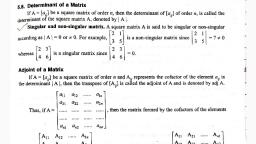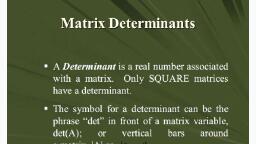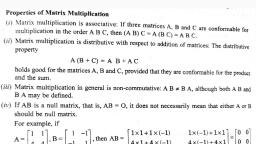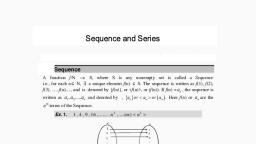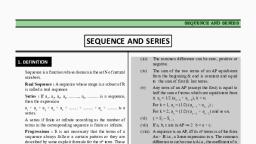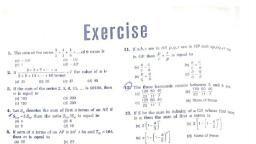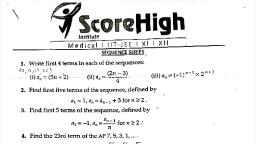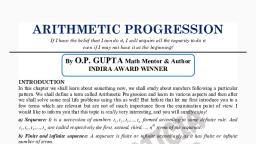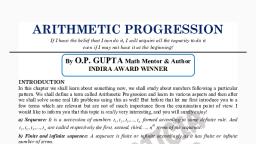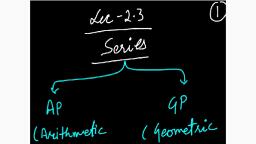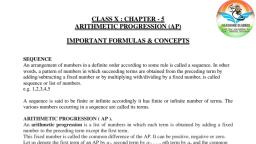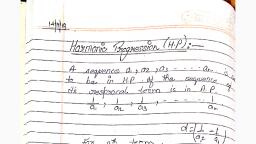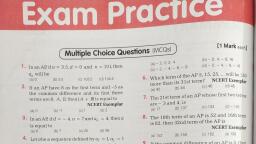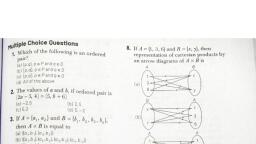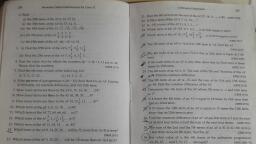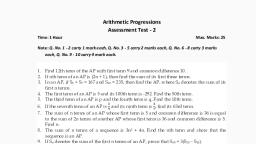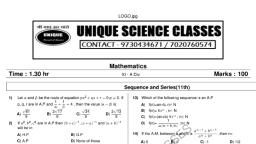Page 1 :
Sequences, and Series, , Sequence, , Sequence is a function whose domain is the set of natural numbers or, some subset of the type {1,2,3,...,k}. We represents the images of, 1, 2, 3,...,n,... as f,f,h,---,f,---, where f, = f(n)., , In other words, a sequence is an arrangement of numbers in definite, order according to some rule., , e A sequence containing a finite number of terms is called a finite, sequence., , e A sequence containing an infinite number of terms is called an, infinite sequence., , e A sequence whose range is a subset of real number R, is called a, real sequence., , Progression, A sequence whose terms follow a certain pattern is called a progression., , Series, , If a,,@2,@3,...,d,,--. is a sequence, then the sum expressed as, , @, + Gy + G, +... + G_+... is called a series., , e A series having finite number of terms is called finite series., , e A series having infinite number of terms is called infinite series., , Arithmetic Progression (AP), , A sequence in which terms increase or decrease regularly by a fixed, number. This fixed number is called the common difference of AP., e.g. a, a+d,a+ 2d,... is an AP, where a = first term and d = common, difference.
Page 2 :
nth Term (or General Term) of an AP, If a is the first term, d is the common difference and / is the last term, of an AP, i.e. the given AP is a,a+d,a+2d,a+ 3d.,..., l, then, , (a) nth term is given by a, =a+(n-1)d, , (b) nth term of an AP from the last term is given by a, = 1-(n - 1)d, Note, , (i) a, +a, =a+l, i.e. nth term from the begining + nth term from the end, = first term + last term, (ii) Common difference of an AP, , d=a,-a,_,Wn>1, (iil) a, = 5 [n-« +A LK <A, , Properties of Arithmetic Progression, (i) Ifa constant is added or subtracted from each term of an AP, then, the resulting sequence is also an AP with same common, difference., (ii) If each term of an AP is multiplied or divided by a non-zero, constant k, then the resulting sequence is also an AP, with, , common difference kd or ; respectively, where d = common, , difference of given AP., , ii) Ifa,,a, ,, and a, , are three consecutive terms of an AP, then, 2an 41 =a, + Gy, 42(iv) If the terms of an AP are chosen at regular intervals, then they, form an AP., (v) If a sequence is an AP, then its nth term is a linear expression in, n, i.e. its nth term is given by An+B, where A and B are, constants and A = common difference., , Selection of Terms in an AP, (i) Any three terms in AP can be taken as, (a-d),a, (a+d), (ii) Any four terms in AP can be taken as, (a - 3d),(a - d),(a + d),(a + 3d), , (iii) Any five terms in AP can be taken as, (a - 2d),(a - d),a,(a + d),(a + 2d)
Page 3 :
Sum of First n Terms of an AP, Sum of first n terms of AP, is given by, , S, = 5 a +(n-1)d]= 7 [a+ 1], where J= last term, , Note, (i) A sequence is an AP iff the sum of its first n terms is of the form, An? + Bn, where Aand Bare constants and common difference in such, , case will be 2A., , (ii) a =S, -S,-, i.e., nth term of AP = Sum of first n terms - Sum of first (n - 1) terms, , Arithmetic Mean (AM), (i) Ifa, Aand b are in AP, then Ais called the arithmetic mean of a, and 6 and it is given by A= ate, , , , (ii) If a,, ay, a,,...,@, are n numbers, then their AM is given by,, Aa Mit ett Gy, n, (iii) Ifa, A,, Ag, Az,...,A,, are in AP, then, , (a) A,, Ag, A3,...,A, are called n arithmetic mean between a, and b, where, , , , , , , , na+b, s@4ds, = n+1, (n - 1l)a + 26, =a+ 2d = ————_—_., =" n+1, dlenesiee © etdn, n+1 n+1, , (b) Sum of n AM’s between a and 6 is nA, , ie. bod A 2h, woh hes a, , 2
Page 4 :
Important Results on AP, , (i) Ifa, =qanda, =p, thena,, ,=0,a,=p+q-r, (ii) If pa, =qa,, then a, , , =0, (iii) Wa, = anda, =, then a,, =1, (iv) IfS, =qand S, =p, thenS,,,=-(p+@, (v) IfS, =S,,thenS,,,=0, (vi) Ifa’, 6” and C are in AP, then, 1 1 1, , a 6 c, ‘ ‘ and —,, ‘, b+cct+aat+b b+c c+a a+b, , (vii) If a,, @,..., d, are the non-zero terms of an AP, then, , 1 1 1 1 n-1, ——+——+ + + =, , a, G0; 0, ~ 4,0, a4,, , both are also in AP., , , , , , , , , , , , , , , , , , , , , , Geometric Progression GP, , A sequence in which the ratio of any term (except first term) to its just, preceding term is constant throughout. The constant ratio is called, common ratio (r)., , Le. Gn =p Yn>1, , a,, , If a is the first term, r is the common ratio and / is the last term of a, , GP, then the GP can be written as a,ar,ar”,...,ar"~',...L., , nth Term (or General Term) of a GP, , If a is the first term, r is the common ratio and / is the last term, then, , (i) nth term of a GP from the beginning is given by a, = ar"~!, , Gi) nth term of a GP from the end is given by a, =, , , , rel, , (iii) The nth term from the end of a finite GP consisting of m terms, isiare, (iv) a,a;, = al, i.e. nth term from the beginning x nth term from the end, = first term x last term, , Properties of Geometric Progression, , (i) If all the terms of GP are multiplied or divided by same non-zero, constant, then the resulting sequence is also a GP with the same, common ratio., , (ii) The reciprocal of terms of a given GP also form a GP.
Page 5 :
(iii) If each term of a GP is raised to same power, then the resulting, sequence also forms a GP., , (iv) If the terms of a GP are chosen at regular intervals, then the, resulting sequence is also a GP., , (v) If a,,a2,a,,....,a, are non-zero and non-negative term of a GP,, then log a,, log ay, log a, ,... , log a, are in an AP and vice-versa., , (vi) If a, band c are three consecutive terms of a GP, then b? = ac., , Selection of Terms in a GP, , (i) Any three terms in a GP can be taken as £& ,aand ar., , (ii) Any four terms in a GP can be taken as ,ar andar’., , >, , “wh fey, 18 sI]a, , (iii) Any five terms in a GP can be taken as ,a,ar and ar’., , ’, , Sum of First n Terms of a GP, (i) Sum of first n terms of a GP is given by, , , , , , n, , { aa-r") ) sep <t, l-r, , S, =4 er" -)) ifr >1, , r-1 ’, na, ifr=1, , (ii) g fo Fs oe el, , 1l-r r-l, , where, / = last term of the GP, , Sum of Infinite Terms of a GP, , (i) If Irl<1, then S, = —*, , , , 1-r, (i) If |r|>1, then S,, does not exist., , Geometric Mean GM, , (i) Ifa, G, bare in GP, then G is called the geometric mean of a and, b and is given by G = Vab., , (ii) GM of n positive numbers a,,a,q,,...,a,, are given by, G =(aqap...0,)""

